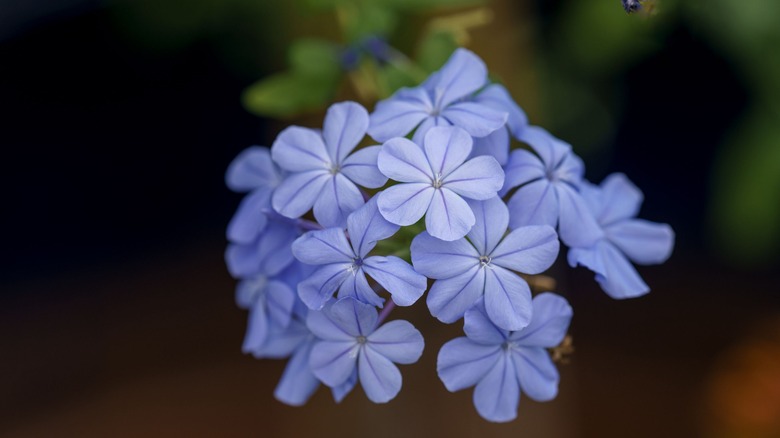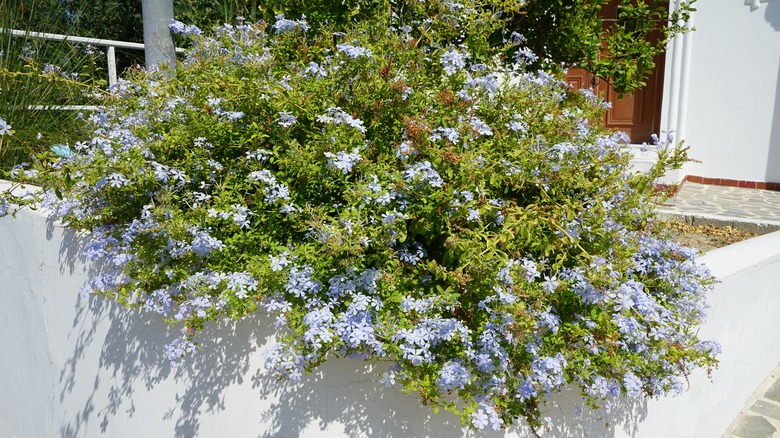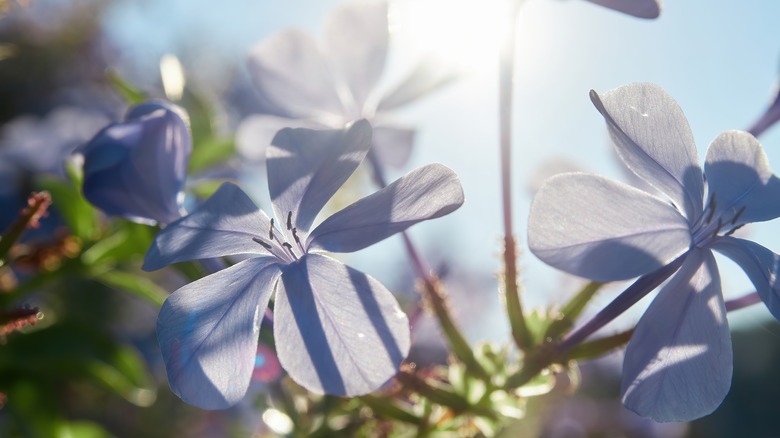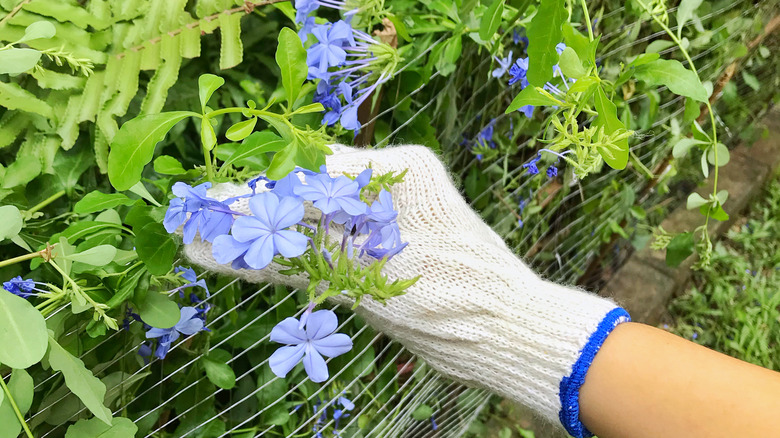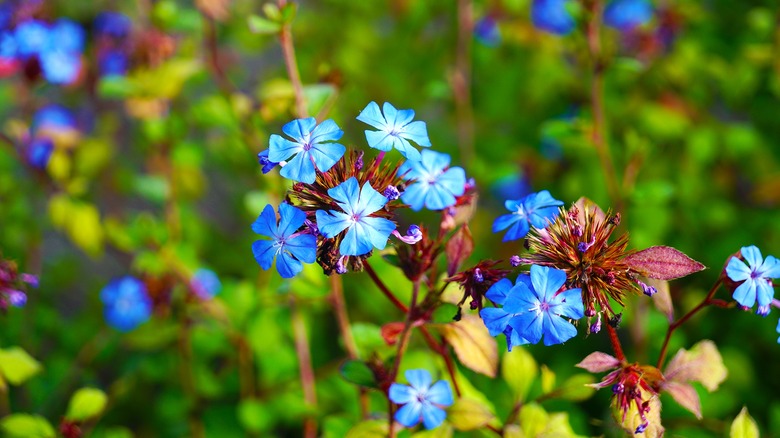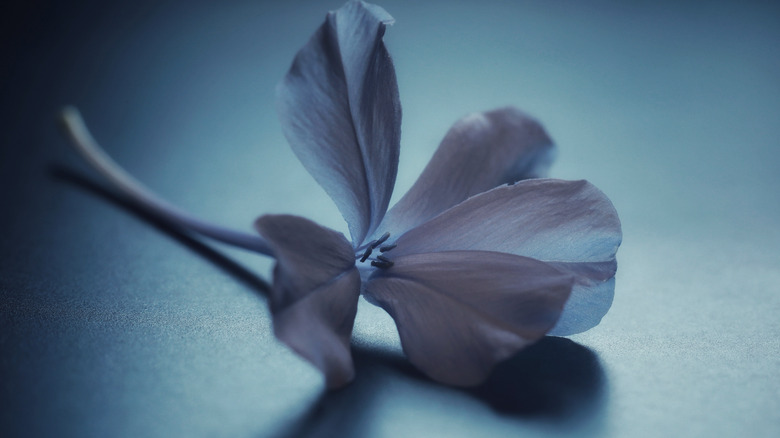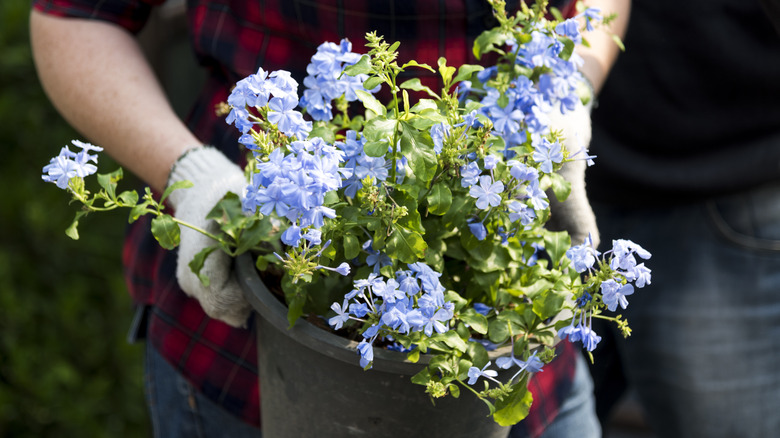Plumbago: Everything You Should Know Before Planting
Plumbago (Plumbago auriculata) is a beautiful shrub full of bluish-violet flowers that is mostly seen in South Africa and in warm areas of the United States, such as Texas and Arizona, according to Gardening Know How. This shrub, also known as the sky flower, can grow 6 to 10 feet tall and 8 to 10 feet wide, as flowers grow profusely around it. Not only is this plant beautiful, but it's also deer resistant, making it a perfect addition to your garden.
A native of South Africa, plumbago is a Latin word that means "resembling lead," according to Gardening Solutions. For those who love blue butterflies, you'll be pleased to know that their larvae are often seen on this plant before becoming caterpillars. A bonus is that gardeners have noted that they've seen very little caterpillar damage to their plants. With over 12 species, this stunning plant can be a great addition to your garden.
How to use plumbago in garden
Depending on where you live, it is advised to grow plumbago in a large container, according to Gardening Know How. During the warm months, plumbago can enjoy being outside as it thrives in the heat. However, once the temperature drops, you should bring your shrub inside to protect it from freezing.
Those who live in climates that are warm year-round can feel free to plant their plumbago in the garden. Since plumbago is a shrub plant, The Tree Center says to plant it in groups and in several locations within your garden to create balance. It's also advised to plant it randomly instead of in a straight row so that the different sizes can contrast each other. No matter how you decide to plant your plumbago, be sure to place it somewhere with full sun if you want the best blooming experience — partial sun is okay too.
How to grow plumbago
Master Class advises gardeners to start off by planting their plumbago seeds in a container and then move them outside once the temperature warms up — this way, you can start the growing process in a safe environment. Since these seeds harden quickly, you should start sometime in the spring, closer to summer. When planting your plumbago seeds, be sure to only use one seed per pot. The seed must be inserted a quarter of an inch deep into the soil and should be covered properly to prevent contact with sunlight and air. You'll want to wrap your containers with plastic and then find a well-lit area to place them. You should occasionally lightly spray water on the top layer of soil to keep it moist.
Once a month passes, your little seedlings are ready to go outside. Place them outside in the shade and protect them from any harsh conditions as they develop a hardened shell. After a year passes of carefully tending to them, they should be ready for their final planting location. Make sure to choose a location in full or partial sun and to dig a hole deep enough to fit all of the roots.
How to care for plumbago
Luckily, this plant is simple and doesn't need anything special to stay healthy, according to Gardening Know How. After you've found the perfect sunny spot for your plumbago, it's best to use well-drained soil that is fertile. However, it can survive in almost any sort of foundation, such as clay, sand, loam, and more.
Nature and Garden points out that the watering schedule is specific: From spring to early fall, the plant will want to be watered regularly but never overwatered. Once winter hits, you can reduce its water consumption. As spring and summer return, sprinkle a bit of plant fertilizer every two weeks to keep your shrub happy.
For those who have to plant their plumbago in a container due to upcoming cold temperatures, make sure it has enough room to grow properly. The soil should be a good potting medium, meaning either peat moss, perlite, vermiculite, or sand. Some of these should be mixed together with a bit of fertilizer to provide your plant with the perfect amount of nutrients as it spends its time away from the sun. If you notice any parts of the plant damaged by frost, it is important to cut them off before spring comes, according to Gardening Solutions.
Plumbago varieties
No matter what variety of plumbago you choose, every one of them is sure to turn out beautifully. Many of the flowers take on a similar shape, but the color variety is stunning, according to Garden Lovers Club.
-
C. willmottanium, also known as the Chinese plumbago, is a lighter blue that has an ombre effect. It is a smaller variety, only growing about 4 feet tall and wide.
-
P. indica, also known as the scarlet plumbago, is a bright red plant that kids and pets should stay away from due to its poisonous nature.
-
P. europaea has light violet flowers with petals that are wide and narrow. This variety is native to the Mediterranean and the Middle East.
-
C. minus has small, blue flowers that can survive hot temperatures. The petals have a tendency to fold up and create a heart shape.
-
C. griffithii takes about five years to grow 3 feet high. Most of the year, the leaves maintain a green color until fall hits, and then they turn red.
Is plumbago toxic?
Although this plant is beautiful, it is also toxic, according to Gardeners' World. Not only is the fruit it produces toxic, but also the bark, pollen, seeds, roots, seed capsules, foliage, and sap — so basically every part of the shrub. If ingested, it will cause an upset stomach and irritated eyes, among other potential symptoms. These effects are typically limited to people — wildlife and house pets likely won't experience toxicity poisoning if ingesting or coming into contact with the plant.
Children's Health Queensland notes that plumbago may cause skin irritation, blistering, and dermatitis when touched. Lotus Magus says that if you come in contact with the plant and notice irritation, you should immediately wash the area with soap and water. If the pain and redness are still present, then you may need to see a doctor. In extreme cases, poison control may also need to get involved.
How to repot plumbago
Nature and Garden says repotting plumbago every two years is important in order for the plant to renew its nutrients and for the flowers to continue to bloom gracefully. The type of pot you use is also important, says Garden Guides. Due to the plant's desire to be out in the sun, the pot must either be made of unglazed clay or wood so that heat isn't trapped and the plant can breathe. You'll want to fill the pot halfway with a mixture of potting soil and sand to create the well-drained soil it desires.
Once the pot is ready, it's time to remove the plumbago from its current container. This is done by laying the pot on its side and carefully pulling until the roots come out. Once this is done, you can place the plumbago into the center of the new pot, add more soil mix, and then the job should be done.
